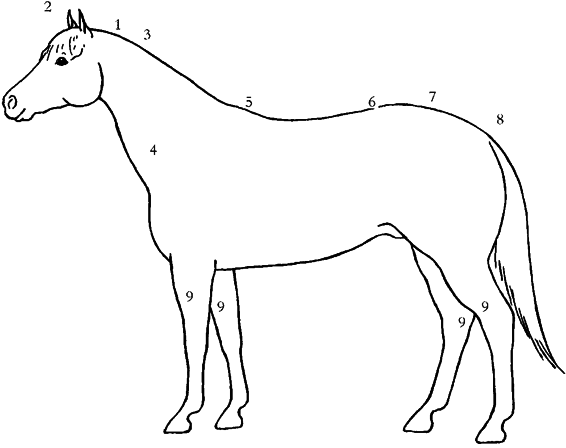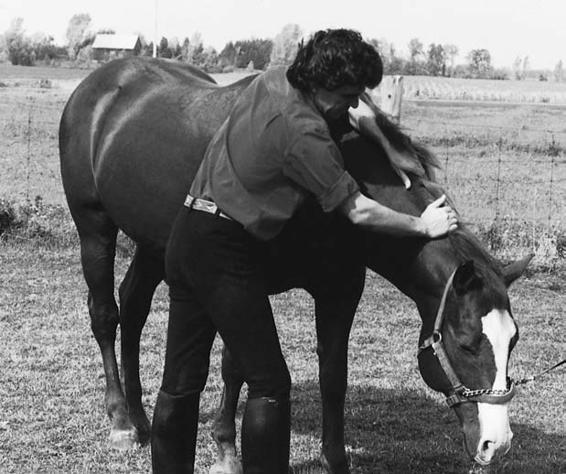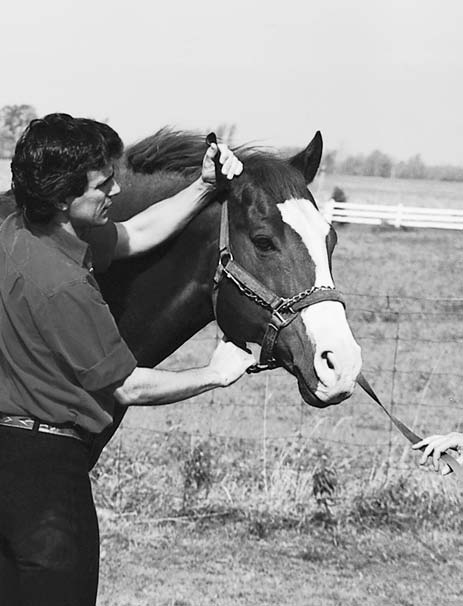Equine Massage: A Practical Guide (24 page)
Read Equine Massage: A Practical Guide Online
Authors: Jean-Pierre Hourdebaigt

In most acute stages, the contracture or spasm will release shortly after the first treatment—within 30 minutes or a couple of
116
Equine Massage
hours. If the contracture is in a chronic stage, it might take several treatments to produce a positive result.
In the case of a torn muscle, the origin-insertion technique is contraindicated in the acute stage.
When using this origin-insertion technique to strengthen a healthy muscle, you must reverse the direction of your pressure by pressing over the tendon area (see neuromuscular technique, page 106) toward the belly of the muscle. In this case you may apply the technique for about 5 to 10 minutes at a time, proportional to the muscle size. Repeating the treatment several times over a few days will show tremendous improvements.
In all cases, follow with a stretch but only if there are no torn muscle fibers!
Cold hydrotherapy is beneficial before and after treatment.
Cold hydrotherapy reduces nerve irritation and cools down the inflammation. The vasoconstriction followed by the vasodilation reaction will flush the toxins from the muscle and provide new nutrients and oxygen. Heat would be more appropriate to deal with a weak muscle.
The origin-insertion technique is used a lot in maintenance and preventative massages to stimulate and strengthen weak muscles. The technique also reduces hypertonic muscles and fine-tunes muscle groups under constant stress.
The SEW/WES Approach
Technique
The SEW/WES approach technique is very important in massage work. It gives you the proper approach for warming-up and for draining any area you wish to work on.The title of this technique is made up of two acronyms. The acronym SEW stands for Stroking, Effleurage, and Wringing, while the acronym WES
stands for Wringing, Effleurage, and Stroking.
The SEW approach is used to start and progressively warm up any area you are to massage. Always start with very light and gentle strokings (0.1 to 0.5 pound of pressure) over the area you will be massaging. Then follow with two to three effleurage passes (2 to 3 pounds of pressure) to thoroughly cover the entire area draining towards the heart. Now apply gentle wringing (2 passes back and forth, using 3 pounds of pressure) over the whole area.
Follow with a set of effleurages and continue with either kneading, and/or gentle friction depending on the nature of your goal.
Remember to intersperse with effleurages every 20 seconds.
Massage Techniques
117
The WES approach is used when you are finished with the deeper aspect of the massage. This approach will allow you to properly and progressively move out of the area you worked on, ensuring proper drainage. After the last set of effleurages following your deeper massage work, apply a gentle but firm set of wringing over the entire area worked on (2 passes, back and forth, using up to 5 pounds of pressure). Follow with extra effleurages, twice as many as usual (4 to 6 passes) to thoroughly drain the tissues you have massaged. With each effleurage pass you should release your pressure a little, starting around 5 pounds and ending with 2 pounds. Then finish with a light stroking, covering the entire area. The last bit of stroking in the WES approach can become the opening stoking of the SEW approach to the area you will massage next.
The various techniques presented here will sharpen your skills and
ensure the best work possible to assist the horse in his recovery or
maintenance program.They will make your work more specialized,
more effective, and much more fun.
6
MASSAGE ROUTINES
A massage routine is a series of massage moves or techniques arranged in a specific order to achieve the best results in the shortest time. For example, there are relaxation, maintenance, and recuperation routines, all designed to address particular situations in the most effective way possible. These routines can contribute to the maintenance and preventive care of your animal while simultaneously giving you feedback on his general health; all these factors affect training and performance.
Thus when a horse is restless, scared, or upset, especially after a long trailer trip, a relaxation routine will ease him fairly quickly.A maintenance routine will keep the muscular structure free from trigger and stress points while improving your horse’s performance. When your horse has been training heavily, a recuperation routine will help shorten the recovery time and prevent the tightening up and stiffening of the locomotor structures.Warm-up and cool-down routines will assist the animal just before and after riding. The “trouble spot” routine will help prevent muscular problems in the heavily exercised horse.
To ensure proper maintenance, most routines should be applied on a regular basis. Such a schedule will give you frequent feedback on the physical and emotional well-being of your animal while developing his confidence during your work.This confidence will cause him to become deeply relaxed and to trust you more and more, responding fully to your treatments.
The relaxation routine can be applied at any time. It is mainly used to make initial contact with the animal, before and after traveling, when putting him to rest, before a show, after a fright, and so on.When done in a shorter version, the relaxation routine can be used to start any form of massage treatment.The head massage routine can be done any time to ease the horse’s tension and can
118
Massage Routines
119
be incorporated into the relaxation routine as well, especially during a first-time massage session.
If the horse is in an average training program, the maintenance routines should be done regularly, once or twice a week. If the horse is participating in a competitive, more demanding program, maintenance routines should be used on a daily basis.
The recuperation routine should be given after every heavy training session. When a heavy training program ends, apply this routine daily for a few days until the transition to a slower-paced program is complete.
To ensure the effectiveness of any massage routine it is best if you can work the horse in a special location with a quiet atmosphere, free from distraction and noise.You can work the horse in his stall, but sometimes it is better to take him somewhere else, like a quiet aisle, another barn, or outdoors if weather permits. Avoid windy conditions as they make the horse nervous.
With practice you will become familiar with the routines outlined in this chapter.The types of movement, the rhythm, and the pressure are particular to each routine; they are selected and put in a particular order to ensure specific results. Always start working with a gentle approach, progressively increasing your pressure and rhythm when needed.
You will be able to add your own touches and eventually create your own routines according to your aims and the conditions you are treating.Trust your own judgment and be creative. But for safe and effective work in the beginning, follow the guidelines given here.
These routines are designed for healthy animals. If abnormal problems or symptoms arise, check with a veterinarian before proceeding.
Relaxation Routines
Horses, like humans, experience different kinds of stress, ranging from the physical (exercise, training schedules, workload) to the emotional (boredom, anxiety, fear).
When a horse is stressed his body will show tension, but the original stress itself is in the brain. The purpose of the relaxation routine is to relieve this stress in a quick and efficient way. To do this, you need to massage very specific areas of the anatomy so as to influence the brain directly or indirectly.
Two routines will relax your animal: the relaxation massage routine and the head massage routine. The second routine complements the first but both can be applied separately. Both routines require very little pressure (2 or 3 pounds maximum) and the

120
Equine Massage
rhythm of your movements should be very smooth (1 move per second on average). Performed independently or together, the routines will achieve positive results over the course of one to several treatments. Neither routine will put your horse to sleep, but each will induce relaxation and a strong sense of relief.This relaxation will clear nervous tension and blockages, regenerating the flow of vital energy through the spine to the rest of the body.
Your horse will feel an overall improvement as a result of these treatments. The relaxation routine is very effective in inducing deep relaxation in a short time and is good to use when massaging a horse for the first time. Even strong-willed horses will soften dramatically after several relaxing massage sessions, becoming more enjoyable companions to ride. The head massage routine is a great addition to this work; however, a head-shy horse may need a little more time to get used to how good it feels to have his face touched.
The Relaxation Massage Routine
The relaxation massage routine concentrates on the nervous system only, using mostly pure nervous reflex massage moves over the spinal column—the neck, the back, the sacrum, and the tail—
to elicit the parasympathetic nervous response (see chapter 1).
6.1 Relaxation Massage Routine

Massage Routines
121
6.2 Lowering the Head:
Relaxation routine.
Before beginning the routine, it is important to stand beside the horse for a few minutes to establish a rapport. Spend a few moments gently stroking the horse’s face and the base of the ears.
This version of the relaxation routine does not include working the face because the point is to relax the animal within a short period of time.
Here is the relaxation routine outline (see figure 6.1): Talk quietly to the horse and gently massage the poll and the upper neck with light muscle squeezings. Lower the horse’s head until it is level with the withers, thus helping the animal relax his back muscles. Continue talking in a soft voice to reinforce the relaxing atmosphere. Hold the halter lightly but firmly with the left hand and with the right hand massage the crest of his neck over a couple of inches, starting directly behind the poll with light muscle squeezing, 2 or 3 pounds of pressure at the most.Apply 20
to 30 gentle muscle squeezings to trigger the parasympathetic nervous response.
As the horse relaxes, you can let go of the halter with your left hand and stroke his nose ridge.

122
Equine Massage
Ear Work
Gently pull the ears (point 2; figure 6.1) from the base to the tips, stretching them sideways.Then gently and very lightly rub the tips between your fingers for 1 or 2 minutes. This will soothe the horse. If your horse does not like his ears being worked, don’t do it. Spend more time massaging the crest of the neck behind the poll.
Neck Crest Work
With both hands, use the muscle squeezing move along the whole crest of the neck (point 3; figure 6.1) from the base of the skull down to the withers in one pass.Your pressure should be firm but not heavier than 5 to 8 pounds, your rhythm smooth and slow with 1 muscle squeeze per 2 seconds.This particular approach will have a very soothing effect. Most horses lower their heads willingly in this sequence. In that case, you might make a second pass to reinforce this relaxed feeling.